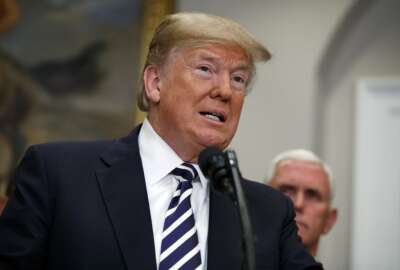

My concern with respect to these executive orders is that they make civil service reform less likely. There are many areas where agreement between the right and...
This column was originally published on Jeff Neal’s blog, ChiefHRO.com, and was republished here with permission from the author.
Last week I wrote about the president’s new Executive Order Promoting Accountability and Streamlining Removal Procedures Consistent with Merit System Principles. The president also issued two additional executive orders:
Ensuring Transparency, Accountability, and Efficiency in Taxpayer Funded Union Time Use
These two orders are focused on collective bargaining and union use of official time. I am covering them together because both are focused on the institutional rights of unions and how the federal government approaches its dealings with them.
Any look at official time has to go back to the beginning of federal collective bargaining. In January 1962, President John F. Kennedy issued Executive Order 10988 — Employee-Management Cooperation in the Federal Service. Section 9 of the EO provided for limited amounts of official time. It said “Solicitation of memberships, dues, or other internal employee organization business shall be conducted during the non-duty hours of the employees concerned. Officially requested or approved consultations and meetings between management officials and representatives of recognized employee organizations shall, whenever practicable, be conducted on official time, but any agency may require that negotiations with an employee organization which has been accorded exclusive recognition be conducted during the non-duty hours of the employee organization representatives involved in such negotiations.”
Collective bargaining was codified by the Civil Service Reform Act of 1978, which included the federal labor relations statute commonly referred to by its location in the United States Code — Chapter 71. Under “Findings and Purpose,” Chapter 71 provided that:
(1) experience in both private and public employment indicates that the statutory protection of the right of employees to organize, bargain collectively, and participate through labor organizations of their own choosing in decisions which affect them —
(A) safeguards the public interest,
(B) contributes to the effective conduct of public business, and
(C) facilitates and encourages the amicable settlements of disputes between employees and their employers involving conditions of employment; and
(2) the public interest demands the highest standards of employee performance and the continued development and implementation of modern and progressive work practices to facilitate and improve employee performance and the efficient accomplishment of the operations of the government. Therefore, labor organizations and collective bargaining in the civil service are in the public interest.
Section 7131 provides for official time for collective bargaining and representational duties. It specifically provides that such official time “shall be granted official time in any amount the agency and the exclusive representative involved agree to be reasonable, necessary, and in the public interest.” It dropped the provision of EO 10988 that negotiations might have to occur during non-duty hours. The amounts of official time are negotiable and are not capped by the law.
The executive order is intended to reduce the amount of official time. It creates a new term — “union time rate” — defined as the total number of duty hours in the fiscal year that employees in a bargaining unit use for taxpayer-funded union time, divided by the number of employees in such bargaining unit. The intent is that agencies not agree to a “union time rate” of more than one. The order also limits individual employees from spending more than 25 percent of their duty hours on official time, and restricts agencies from agreeing to provide office space, equipment and services to unions. The executive order also bans use of official time for lobbying and internal union business.
The provisions regarding the “union time rate” are negotiable, as is the limit of 25 percent official time. Proposals to have union representatives on 100 percent official time are common, as are agency proposals to limit employees to a fixed percentage of their duty hours. I know from personal experience that unions are not likely to agree to them, setting up disputes that will end up before the Federal Services Impasses Panel, the Federal Labor Relations Authority and the courts. Therefore it is unlikely we will see significant changes implemented immediately. The provisions banning use of official time for internal union business is not negotiable because it is already illegal. Chapter 71 specifically prohibits such activities.
The second executive order focuses on approaches to collective bargaining. It says “CBAs, and other agency agreements with collective bargaining representatives, often make it harder for agencies to reward high performers, hold low-performers accountable, or flexibly respond to operational needs. Many agencies and collective bargaining representatives spend years renegotiating CBAs, with taxpayers paying for both sides’ negotiators. Agencies must also engage in prolonged negotiations before making even minor operational changes, like relocating office space.”
To solve those perceived problems, it creates an interagency Federal Labor Relations Working Group, requires a more structured approach to negotiating contracts, and places limits on the time agencies should spend in bargaining. It specifically requires agencies to eliminate predecisional involvement required in executive orders issued by Presidents Clinton and Obama.
Many participants in collective bargaining would agree that negotiations often take far too long. Sometimes delays are caused by legitimate disagreements that the parties are working to resolve. At other times the delays are caused by people who are more interested in playing games than resolving differences. The game players are not limited to the union side of the table. I have worked many labor relations professionals who viewed bargaining as a game that they were determined to win. I have also worked with union officials who would not reach agreement on anything solely to keep an agency from acting. Neither of those approaches is constructive and they certainly do not adhere to the finding of the Congress in Chapter 71 that “labor organizations and collective bargaining in the civil service are in the public interest.”
Creation of a management-only Federal Labor Relations Working Group is not inconsistent with law. Nor is taking a harder line on collective bargaining or eliminating predecisional involvement. However, it puts the government and unions on a far more adversarial footing.
My own experience is that predecisional involvement made agreements more likely and reduced the amount of time we spent in bargaining. Building an effective relationship with the union(s) was possible and in the agency’s interest. The last time I served as chief negotiator for an agency, we reached agreement on a full contract in 12 days.
The content of these two executive orders is likely to be litigated for the next few years. I do not have a crystal ball, so I will not predict how that litigation will turn out. The provisions of Chapter 71 and the 40 years of case law that resulted will inform the decisions of the Impasses Panel, the Federal Labor Relations Authority and the courts.
My concern with respect to these executive orders is that they make civil service reform less likely. Those on the left, right and in the center generally agree that we need to modernize aspects the civil service. There are many areas where agreement between the right and left is a possibility. The issue of labor relations is not high on that list. Whenever the subject turns to unions, Democrats and Republicans retreat to their respective camps and lob bombs at one another, because both believe it is in their political interest to maintain the status quo.
I do not believe reform of labor relations or any other aspect of the civil service should be off the table. That kind of precondition to reform is the reason we have not seen real reform in 40 years. Every time we talk about civil service reform, all of the parties start laying out their “off the table” subjects. By the time we get to serious talk, there is nothing left to talk about and nothing changes.
I also believe that the only way we are going to modernize the civil service is through a nonpartisan approach where the reforms are driven by good government needs rather than politics. I continue to believe that a nonpartisan commission modeled on the Hoover Commission, with an implementation mechanism similar to the Base Realignment and Closure Commissions, is the only way we will get comprehensive modernization of the civil service.
Jeff Neal is a senior vice president for ICF and founder of the blog, ChiefHRO.com. Before coming to ICF, Neal was the chief human capital officer at the Homeland Security Department and the chief human resources officer at the Defense Logistics Agency.
Copyright © 2025 Federal News Network. All rights reserved. This website is not intended for users located within the European Economic Area.


